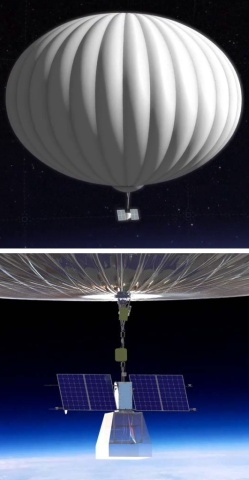Purpose of the flight and payload description
The Thunderhead Balloon System is a steerable multipurpose platform developed by Raven Aerostar for stratospheric missions of long duration, with navigational capabilities and the ability of performing persistent flight over areas of interest. The balloons can be flown individually or in constellations to support a wide range of requeriments including intelligence, surveillance, and reconnaissance; serve as an alternative to satellite communications or make surveys of ground, marine and environmental objectives.
The heart of the system is a superpressure balloon to which is attached a gondola containing the payload, flight systems and solar panels.
The balloon is a pumpkin-shaped superpressure model made of polyethylene in several sizes with a volume varying from 64.000 cubic feet to 400.000 cubic feet and altitudes of flight of between 50 and 65 kft for the smaller ones and between 75 and 92 kft for the bigger ones. This is well above commercial jetliners and weather phenomena. Both models can carry a payload of up to 125 pounds. To inflate the balloon is used helium and once it reach float altitude it expands and pressurises acquiring the final pumpkin shape. Inside the main balloon there is a smaller one called "balloonet" which serves as ballast and is the heart of the Thunderhead steering system: air is introduced into it using a special built pump permitting the balloon to modify its weight for ascent or descent. Although is not possible to directly control course or speed, these altitude changes allows the balloon to take advantage of different wind patterns at different altitudes for navigation. The balloon is also equipped with a valve at the top which is used to introduce helium during inflation and to vent helium during flight. The average flight duration can range from a few days to two months.
The instrumented gondola is attached directly below the balloon. Is composed of lightweight materials, may vary in size and can be rectangular shaped or truncated pyramid shaped. The upper part of the gondola houses in an insulated compartment the avionics and the elements that are part of the command and control system: ADS-B Out transponder for localization by nearby planes and Air Traffic controllers; RF-based systems for LOS (Line Of Sight) communications; Iridium-based system for BLOS (Beyond Line Of Sight) communications; GPS aided inertial navigation systems for real time positioning and Iridium backhaul as datalink for control and command of the payload. On the sides of this compartment are mounted the solar panels which varies in size according to power requeriments. They provide energy to the whole system during the day while charging onboard batteries for nighttime operations. Protruding ends of the booms on which are mounted the panels also serve to mount GPS and Iridium antennas. In some cases an additional payload compartment is located directly below the instrumented gondola with size and shape specially adapted for the mission requirements. If necessary, insulating panels can be added on the sides to protect onboard equipment and help to counteract the extremes temperatures of the stratosphere. A packed parachute is attached between the bottom of the balloon and the top of the gondola to allow a safe descent of the equipment at mission's end. In some cases, crush pads are fixed to the bottom of the gondola to absorb the shock of the landing.
Thunderhead systems are highly versatile with minimal space requirements for ground operation, so they can be launched by semi-manual means or using specially developed mobile platforms from almost anywhere, including small airfields, open terrain, or even from any vessel in open sea.
Details of the balloon flight
Balloon launched on: 1/31/2023 at 5:11 utc
Launch site: Santa Fe County, New Mexico, US
Balloon launched by: Aerostar
Balloon manufacturer/size/composition: Superpressure balloon with internal ballonet
Flight identification number: HBAL616
End of flight (L for landing time, W for last contact, otherwise termination time): 2/2/2023 at 17:00 utc (L)
Balloon flight duration (F: time at float only, otherwise total flight time in d:days / h:hours or m:minutes - ): 2 d 8 h 49 m
Landing site: 12 km SSW of Encino, New Mexico, US
External references
- Aerostar website
- Interactive flight path of the balloon obtained via ADS-B Exchange
16241If you consider this website interesting or useful, you can help me to keep it up and running with a small donation to cover the operational costs. Just the equivalent of the price of a cup of coffee helps a lot.


